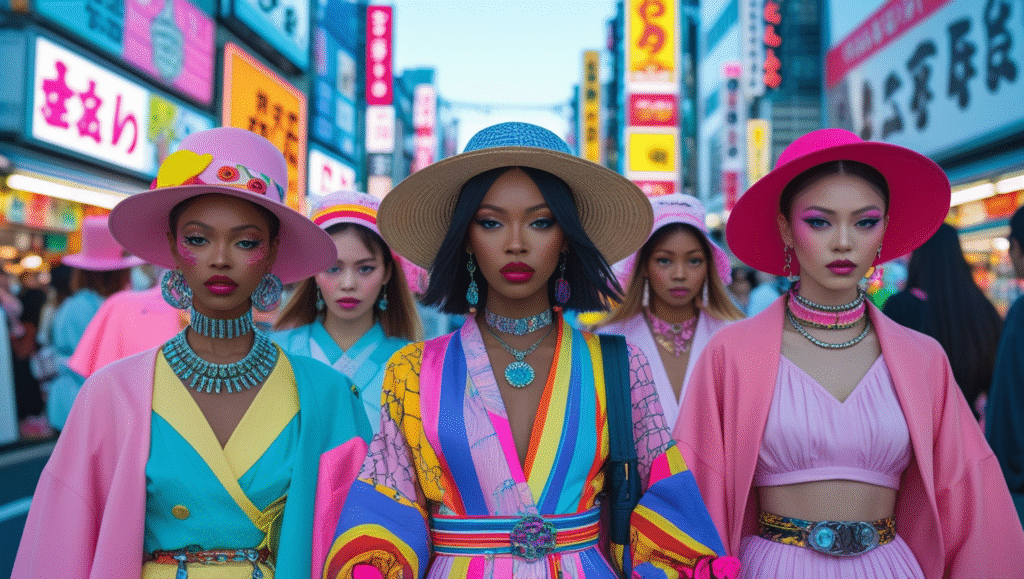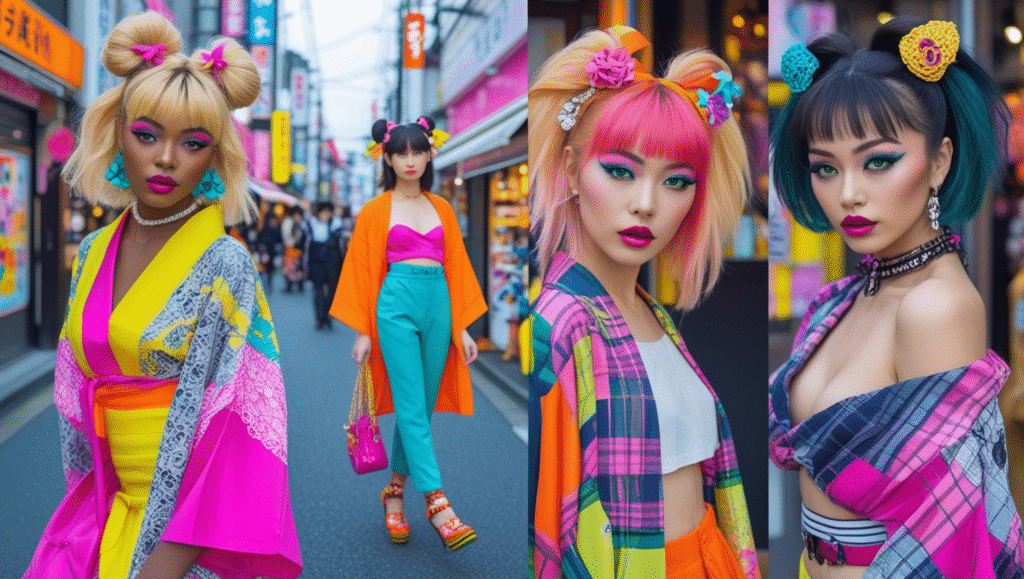Have you ever seen human beings in wild, colored clothes that look like nothing else? Here is Harajuku fashion! It comes from Harajuku, a pleasant neighbourhood in Tokyo, Japan. There, young people dress in ways that show who they are. Harajuku Fashion is a massive playground for clothes, full of shiny colours, fun styles and huge thoughts. Now it’s not just about what to look for; It’s about yourself. This article looks at all the amazing patterns that make Harajuku style so special. Whether you like cute or courageous things, there is something for you!
What Makes Harajuku Fashion Unique?
Harajuku fashion is a style that started in Tokyo’s Harajuku area. It’s famous because it’s so different and complementary. People there don’t follow boring fashion rules. Instead, they mix things up in exciting ways. Some wear fluffy skirts with cartoon characters. Others look like rock stars or princesses. Harajuku fashion lets everyone create their look. It’s been around since the 1970s and 1980s, when kids in Japan started blending Western clothes with their ideas. It’s a big part of Japanese street fashion today, and people worldwide love it!
Kawaii Couture: Cute Meets Fancy
One big part of Harajuku fashion is kawaii couture. “Kawaii” means cute in Japanese, and couture means fancy fashion. So, this style is all about being adorable and stylish. Imagine wearing pastel colours like pink, blue, or yellow. You might see bows, ribbons, or even Hello Kitty on clothes! A kawaii outfit could have a fluffy skirt, a cute t-shirt, and sneakers with sparkly laces. People add fun stuff like heart-shaped hair clips or animal bags. Kawaii couture is popular because it makes you feel happy and playful. It’s perfect for anyone who loves cute things!
Decora Vibrance: Bright and Bold
Next up in Harajuku fashion is decora vibrance. Decora is short for decoration, and this style is about piling on the fun! People wear colourful clothes with lots of patterns. Then, they add tons of accessories—hair clips, bracelets, necklaces, and even stickers on their cheeks. The more, the better! You might see someone with 20 hair clips in every rainbow colour. Decora vibrance is loud and cheerful, and it’s great for standing out. Want to try it? Start with a simple shirt and shorts, then add as many bright accessories as possible. It’s like decorating yourself!
Lolita Elegance: Pretty Like a Princess
Lolita elegance is another style in Harajuku fashion. It’s inspired by old European clothes from hundreds of years ago. Think big, puffy dresses with lace and ribbons. People wear these outfits to look graceful and fancy. Some add bonnets or little umbrellas called parasols. There are different kinds of Lolita looks. Sweet Lolita is cute and has lots of pink. Gothic Lolita is darker, with black and white. Fans love this style because it feels like stepping into a fairy tale. It’s a dreamy way to dress up and feel special.
Gyaru Flair: Flashy and Confident
Gyaru flair brings some sparkle to Harajuku fashion. “Gyaru” means “gal,” and it is about looking bold and glamorous. People who love this style tan their skin, bleach their hair, and wear big makeup. Think sparkly eyeshadow and long eyelashes! Their clothes are tight and flashy—short skirts, high heels, and shiny tops. Gyaru has substyles too, like Kogal, which looks like a cool school uniform, or Hime Gyaru, which is super fancy with big hair. Gyaru flair is all about confidence. It’s for anyone who wants to shine like a star!

Visual Kei: Rock and Roll Vibes
Visual kei is a wild style in Harajuku fashion that comes from rock music. “Kei” means style, about looking like a rock star. People wear spiky hair, dark makeup, and edgy clothes with leather or chains. It’s dramatic and remarkable! Visual kei started with Japanese rock bands that dressed up for their shows. Fans copy their looks to feel rebellious and creative. You might see black jackets, studded boots, or bright red hair. If you like music and want a tough, artsy style, visual kei is a fun choice.
Pastel Goth: Soft and Spooky
Pastel goth is a newer twist in Harajuku fashion. It mixes dark, gothic vibes with soft, cute colours. Typically, the gothic style is all black and spooky. But pastel goth adds pastel shades like pink, purple, or blue. Imagine a black skirt with a light pink top and a skull. Or black boots with pastel laces! People dye their hair in soft colours and wear dark makeup. It’s a terrific way to be edgy and adorable at the same time. Pastel goth is excellent for anyone who likes both spooky and sweet things.
Street Snap: Sharing the Style
Street snap isn’t a style, but a way to show off Harajuku fashion. It’s when photographers take pictures of stylish people walking around Harajuku. These photos end up in magazines or online, showing everyone the latest trends. A famous photographer, Shoichi Aoki, started Fruits magazine to share these looks. Street snap helps spread Harajuku fashion all over the world. It’s like a fashion diary! People love it because they can see real outfits and get ideas. It is a big reason why Japanese street fashion is so famous today.
Cosplay Chic: Dressing Up with Style
Cosplay chic mixes Harajuku fashion with costume fun. Cosplay is when you dress as anime, manga, or video game characters. In Harajuku, people make it extra stylish! They might wear an anime school uniform but add cool accessories like funky socks or a bright bag. It’s different from regular cosplay because it’s for everyday wear, not just events. For example, you could wear a cape like a superhero but pair it with jeans. Cosplay chic lets you show off your favourite characters while looking awesome.
Avant-Garde Pop: Art You Can Wear
Avant-garde pop is a super creative part of Harajuku fashion. “Avant-garde” means new and different, and pop means popular culture. People use weird shapes, big designs, or strange materials in their clothes. Think dresses that look like sculptures or jackets with giant shoulders. Famous designers like Rei Kawakubo inspire this look with their bold ideas. Avant-garde pop mixes fashion with music and movies, too. It’s for people who love experimenting and seeing clothes as more than just something to wear.
Tokyo Trend: Harajuku’s Big Impact
Tokyo trends show how Harajuku fashion changes fashion everywhere. Harajuku is like a testing ground for new ideas. The best ones spread to Tokyo and beyond! Things like bright colours, big shoes, or mixing patterns started in Harajuku. Now, you see them in stores and on runways. Harajuku fashion keeps Tokyo fashion trends exciting and fresh. It’s a small place with a considerable influence. If you want to know what’s cool next, look at Harajuku—where the magic begins!
How to Try Harajuku Fashion Yourself
Want to try Harajuku fashion? It’s easy and fun! You don’t need a whole new closet. Start with one thing you like—a cute bow for kawaii couture or some colourful clips for decor vibrance. Mix it with clothes you already have. The best part is experimenting—try new colours or patterns! Harajuku fashion is all about what makes you smile. There’s no wrong way to do it. So grab something fun, wear it your way, and see how it feels!

The Harajuku Fashion Community
Harajuku fashion isn’t just clothes—it’s people too! In Harajuku, everyone shares their styles and ideas. They meet up, take photos, and cheer each other on. There are groups where fans talk about Tokyo fashion trends and swap tips online. It’s a friendly bunch! Whether you live near Tokyo or far away, you can join us. The community makes Harajuku fashion even more special because it’s about connecting with others who love creativity too.
Why We Love Harajuku Fashion
Harajuku fashion is one-of-a-kind because it’s so free and fun. Love cute stuff? Try kawaii couture. Like dark looks? Go for pastel goth. There’s a style for everyone! It’s brave, colourful, and full of surprises. Harajuku fashion inspires people to play with clothes and show their true selves. Why not add a little Harajuku to your life? It’s a happy way to dress and feel great!
References
- Aoki, S. (2001). Fruits. Phaidon Press.
- Godoy, T. (2007). Style Deficit Disorder: Harajuku Street Fashion – Tokyo. Chronicle Books.
- Kawamura, Y. (2012). Fashioning Japanese Subcultures. Berg Publishers.
- TokyoFashion.com. (n.d.). “Harajuku Fashion Walk.” Retrieved from tokyofashion.com.
